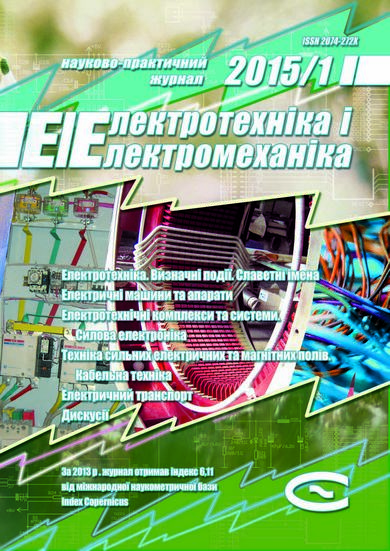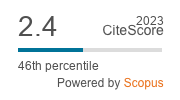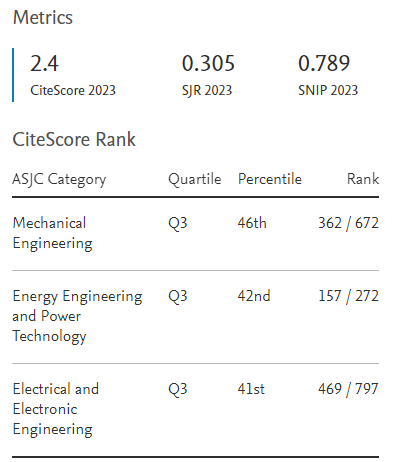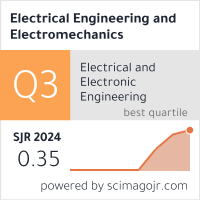STABILIZATION OF PARAMETERS OF ASYNCHRONOUS ELECTRIC DRIVE WITH VECTOR CONTROL
DOI:
https://doi.org/10.20998/2074-272X.2015.1.09Keywords:
electric drive, vector control, stabilizing controllerAbstract
A problem of stabilization of parameters of the asynchronous electric drive vector control system is considered. Usually such systems have two control channels. The synthesis of stabilizing controllers is made for every control channel. The evaluation of variables of system status is made by observer. The problem of stabilizing controllers and observer synthesis consists in calculation of state feedback intensification. Its solution is based on existing approaches form vector control theories, matrix inequalities and Lyapunov stability. Several synthesis methods of stabilizing controllers have been proposed. Structural scheme of vector control system and observer has been built. The simulation of transient processes in the vector control system is carried out with MATLAB computing environment. The most important property of obtained solution is Lyapunov stability of control loops closed-looped by state vectors. Transient processes have been investigated on the particular example. Graphs confirming stability of such processes that flow in the vector control system in minimal period of time have been plotted down.References
Khlopenko N.J., Biljuk I.S., Shevchenko V.V. Optymal'ne keruvannja ob'jektamy: Navchalnyi posibnyk dlia studentiv vyshchykh navchalnykh zakladiv [Optimal control of objects: University students textbook]. Mykolayiv, National University of Shipbuilding Publ., 2013. 172 p. (Ukr).
Korotkov M.F., Pahomov A.N., Fedorenko A.A. Modal control of asynchronous electric drive. Izvestiia Tomskogo politekhnicheskogo universiteta – Bulletin of the Tomsk Polytechnic University, 2014, vol.324, no.4, pp. 69-75. (Rus).
Balandyn D.V., Kogan, M.M. Sintez zakonov upravlenija na osnove linejnyh matrichnyh neravenstv [Synthesis of control rules based on linear matrix inequalities]. Moscow, Fizmatlit Publ., 2007. 280 p. (Rus).
Lyapunov A.M. Obshhaja zadacha ob ustojchivosti dvizhenija [General problem of motion stability]. Moscow-Leningrad, GITTL Publ., 1950. 472 p. (Rus).
Pyatnitskiy Ye.S., Skorodinskiy V.I. Numerical methods of Lyapunov function construction and their application to the absolute stability problem. Systems & Control Letters, 1982, vol.2, no.2, pp. 130-135. doi: 10.1016/s0167-6911(82)80023-6.
Nesterov Y.E., Nemirovski A.S. Interior-Point Polynomial Algorithms in Convex Programming. Society for Industrial and Applied Mathematics, Philadelphia, USA, 1994. 405 p. doi: 10.1137/1.9781611970791.
Boyd S., El Ghaoui L., Feron E., Balakrishnan V. Linear Matrix Inequalities in System and Control Theory. Society for Industrial and Applied Mathematics, Philadelphia, USA, 1994. 185 p. doi: 10.1137/1.9781611970777.
Churilov A.N., Gessen A.V. Issledovanie linejnyh matrichnyh neravenstv. Putevoditel' po programmnym paketam [The study of linear matrix inequalities. Guide to software packages]. Saint Petersburg, Saint Petersburg State University Publ., 2004. 148 p. (Rus).
Maxfield B. Essential PTC Mathcad Prime 3.0: A Guide for New and Existing Users. Amsterdam: Academic Press, 2013.
Terehov V.M., Osipov O.I. Sistemy upravlenija elektroprivodov: uchebnik dlja studentov vysshih uchebnyh zavedenij [Control system of electric drives: high school textbook]. Moscow, Publishing Center "Akademija", 2006. 304 p. (Rus).
Sokolovskij G.G. Elektroprivody peremennogo toka s chastotnym upravleniem [AC drives with frequency control]. Moscow, Publishing Center "Akademija", 2006. 272 p. (Rus).
Downloads
Published
How to Cite
Issue
Section
License
Copyright (c) 2015 N. J. Khlopenko, S. A. Gavrilov, I. N. Khlopenko

This work is licensed under a Creative Commons Attribution-NonCommercial 4.0 International License.
Authors who publish with this journal agree to the following terms:
1. Authors retain copyright and grant the journal right of first publication with the work simultaneously licensed under a Creative Commons Attribution License that allows others to share the work with an acknowledgement of the work's authorship and initial publication in this journal.
2. Authors are able to enter into separate, additional contractual arrangements for the non-exclusive distribution of the journal's published version of the work (e.g., post it to an institutional repository or publish it in a book), with an acknowledgement of its initial publication in this journal.
3. Authors are permitted and encouraged to post their work online (e.g., in institutional repositories or on their website) prior to and during the submission process, as it can lead to productive exchanges, as well as earlier and greater citation of published work.





